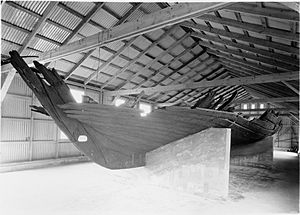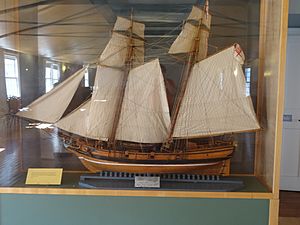Nancy (1789 ship) facts for kids

The recovered wreck of Nancy
|
|
Quick facts for kids History |
|
|---|---|
| Name | Nancy |
| Namesake | Nancy Richardson |
| Builder | Richardson Forsythe and Company |
| Laid down | June 1789 |
| Launched | 24 November 1789 at Detroit |
| Fate | Commandeered for the Provincial Marine |
| Name | Nancy |
| Acquired | Commandeered 1812 |
| Fate | Transferred to Royal Navy 1814 |
| Name | HMS Nancy |
| Acquired | 1814 |
| Fate | Burned and sank, 14 August 1814 |
| General characteristics | |
| Tons burthen | 67 (bm) |
| Length | 80 ft (24 m) |
| Beam | 22 ft (6.7 m) |
| Depth of hold | 8 ft (2.4 m) |
| Propulsion | Sails |
| Sail plan | two-masted schooner |
| Armament |
|
Nancy was a type of sailing ship called a schooner. She was built in Detroit, Michigan, and launched in 1789. For many years, Nancy helped with the fur trade on the Great Lakes. But she is most famous for her role in the War of 1812 between Great Britain and the United States.
Nancy was a very important supply ship for the Provincial Marine, which was a British naval force. In 1814, the Royal Navy took over the Provincial Marine and got Nancy. On August 14, 1814, an American fleet trapped HMS Nancy near the Nottawasaga River. To stop the Americans from capturing her and her valuable supplies, her crew set her on fire. For many years, the wreck was forgotten. But in July 1927, it was found again. The ship's remains were then raised and became the main display at the Nancy Island Museum.
Contents
Building the Nancy
Nancy was built near Detroit for a fur trading company called Forsyth, Richardson and Company. This company was part of the North West Company, a group of businesses in Montreal. At that time, large sailing ships like Nancy were used for trading with Native Americans on the Great Lakes. Smaller birchbark canoes were used for trade further north.
The ship was made from strong white oak and eastern red cedar wood. She was about 80 feet (24 m) long overall. She was 22 feet (6.7 m) wide and could carry up to 350 barrels of cargo. Nancy had two tall masts and sails that helped her move. On the front of the ship, called the bow, there was a figurehead. This was a carved wooden figure of a lady wearing a fancy hat. The ship also had two small brass cannons for defense.
Construction of Nancy began in June 1789. John Richardson, one of the company owners, wrote that the schooner would be "a perfect masterpiece of workmanship and beauty." He said it would be very strong and last a long time. The ship was named after Richardson's oldest daughter. Nancy was launched on November 24, 1789. The next spring, she made her first trip to Fort Erie. For the next 22 years, Nancy was busy in the fur trade. She was sold a few times and had different captains.
Nancy in the War of 1812
When the War of 1812 started between the United States and Great Britain, Nancy was at a dock near Windsor. To keep her safe, she was moved to Amherstburg. The British army commander there, Lieutenant-Colonel St George, took Nancy to use as a transport ship. Before the war, it was noted that Nancy could carry several cannons. She was later armed with two 6-pounder (3 kg) guns and two 24-pounder (11 kg) carronades.
In July 1812, Nancy sailed with another ship to Fort Erie. She brought back military supplies and 60 soldiers. These soldiers then helped in the Siege of Detroit, where the British and their Native American allies captured Detroit. After this victory, Nancy carried troops, supplies, and food between Fort Erie and Detroit. In April 1813, Nancy helped move British troops for an attack on Fort Meigs, which was not successful.
In September 1813, while Nancy was on Lake Huron going to Fort Mackinac, the Americans won a big naval battle called the Battle of Lake Erie. They captured all the British armed ships on the lake. This meant Nancy was the only British ship left on the Upper Lakes. When Nancy returned to the Detroit River, a storm hit. American soldiers on the river bank demanded she surrender. But her captain, Alexander MacIntosh, managed to sail her back into the lake. Even though two American armed ships were waiting, Nancy only got minor damage from musket fire.
On Lake Huron, more storms damaged Nancy's sails and cables. She sailed to Sault Ste. Marie, where her crew spent the winter fixing her.
By taking Detroit, the Americans had cut off the main way the British supplied Fort Mackinac. So, the British found a new route over land from York to Lake Simcoe and then to the Nottawasaga River. This river led to Lake Huron. In May 1814, Lieutenant Colonel Robert McDouall reached Fort Mackinac using this new route. He brought Lieutenant Newdigate Poyntz of the Royal Navy to take charge of the naval forces on Lake Huron, which was mainly just Nancy. Nancy continued to be a supply ship, making three trips between the Nottawasaga River and Mackinac that summer.
The Destruction of Nancy
In July 1814, during one of Nancy's supply trips, an American force left Detroit. They wanted to take back Fort Mackinac. Their attack on the island failed. But they learned where Nancy was hiding from a prisoner. So, three of their ships went to Nottawasaga Bay.
At the Nottawasaga River, Lieutenant Miller Worsley of the Royal Navy was now in command of Nancy. She was about to sail to Mackinac with 300 barrels of food and other supplies. Worsley was warned about the Americans. He had Nancy towed 2 miles (3.2 km) up the river. There, he quickly built a small fort, called a blockhouse. This blockhouse had two 24-pounder carronades and a 6-pounder gun, probably taken from Nancy. Worsley's group included 21 sailors, 23 Ojibwa warriors, and 9 French-Canadian voyageurs.
On August 13, Captain Arthur Sinclair led three American ships into Nottawasaga Bay. The Americans thought Nancy was still on the lake. They planned to wait in ambush for her. But some of their soldiers landed on the shore and found Nancy's hiding place.
The next day, American soldiers attacked Worsley's position. They had a large mortar and guns from their ships. Worsley knew he was outnumbered. He decided to sink Nancy on purpose. This would stop the enemy from capturing her or her valuable cargo. A trail of gunpowder was laid from Nancy to the blockhouse. At four o'clock, Nancy was set on fire. The fire followed the powder trail and caused an explosion in the blockhouse. This explosion surprised the American commander.
After the fight, two American gunboats stayed to guard the river. They wanted to stop supplies from reaching Fort Mackinac. Worsley and his men later removed the blockages in the river. They reached Mackinac in a large canoe after paddling for 360 miles (580 km). With help from soldiers and Native American warriors, Worsley later surprised and captured both American gunboats on Lake Huron.
After the War
After the war, the British government paid the North West Company £2,200 for Nancy being destroyed while in service. They also paid more money for her services between 1812 and 1814.
The story of Nancy's escape on the Detroit River in October 1813 inspired a song. It's called "The Nancy" by Canadian singer Stan Rogers. You can find it on his album From Fresh Water.
Nancy Island Museum
Over many years, silt (fine dirt) from the river built up around the sunken remains of Nancy. This created an island over the ship's hull. The hull was still visible underwater. It was first found in 1911 by C. H. J. Snider, a Canadian marine historian. But it didn't get much attention until after 1924. In August 1924, Snider and others started raising money to recover the wreck.
During the recovery, they found many valuable items. These included cannonballs and parts of the ship's hull. Nancy's figurehead, ship's silverware, and many personal items were found in the river. In 1923, the site was named a National Historic Site. A stone marker was put up in 1954.
In 1927, the remains of Nancy were raised and moved onto the island. The Nancy Museum opened on the island on August 14, 1928. It was built to honor the ship and her important role in the war. In 1968, a new museum opened with videos, a lighthouse, and a theater. Since 1978, the site has been managed by Wasaga Beach Provincial Park.


